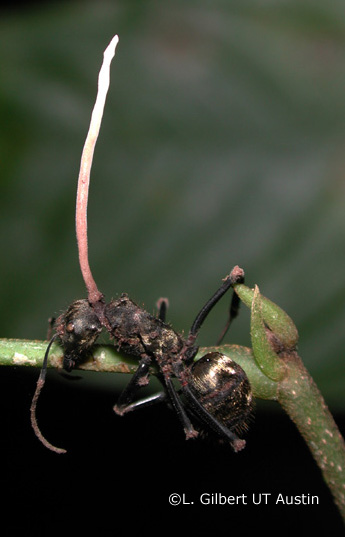[ Ivan Dimkovic @ 12.08.2009. 12:46 ] @
| Priroda nekada stvarno izgleda kao horor film... OK, ose koje ubadaju bube na tacno precizno odredjeno mesto u nervnom sistemu i ubrizgavaju otrov koji im omogucava da njima upravljaju kao sa dzojstikom je jedna stvar... Ali ovo je jos ludje - u pitanju je gljiva, cije spore izazivaju brainwash nesrecnog mrava koji ga tera da ode na tacno predvidjeno mesto (list biljke) i onda se svojim kljestima zakaci za isti... posle cega mu gljiva unisti nervni sistem i nastavlja da lepo raste iz njega: Scary, a? http://neurophilosophy.wordpre.../20/brainwashed-by-a-parasite/ Citat: The carpenter ant in the picture on the right (genus Campanotus), and the bullet ant in the first film clip below (Paraponera clavata), have fallen victim to parasitic fungi of the genus Cordyceps, which manipulate the behaviour of their host in order to increase their own chances of reproducing. The spores of the fungus attach themselves to the external surface of the ant, where they germinate. They then enter the ant’s body through the tracheae (the tubes through which insects breathe), via holes in the exoskeleton called spiracles. Fine fungal filaments called mycelia then start to grow inside the ant’s body cavity, absorbing the host’s soft tissues but avoiding its vital organs. When the fungus is ready to sporulate, the mycelia grow into the ant’s brain. The fungus then produces chemicals which act on the host’s brain and alter its perception of pheromones. This causes the ant to climb a plant and, upon reaching the top, to clamp its mandibles around a leaf or leaf stem, thus securing it firmly to what will be its final resting place. The fungus then devours the ant’s brain, killing the host. The fruiting bodies of the fungus sprout from the ant’s head, through gaps in the joints of the exoskeleton. Once mature, the fruiting bodies burst, releasing clusters of capsules into the air. These in turn explode on their descent, spreading airborne spores over the surrounding area. These spores then infect other ants, completing the life cycle of the fungus. Depending on the type of fungus and the number of infecting spores, death of an infected insect takes between 4-10 days.  |